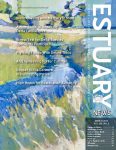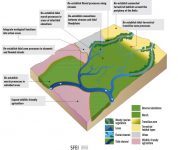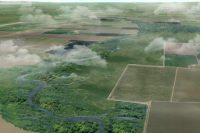 DOWNLOAD the March 2017 Issue PDF
DOWNLOAD the March 2017 Issue PDF
By Ariel Rubissow Okamoto
Chris Rose likens a 500-acre farm in the northwest Delta to a bakery in downtown Manhattan. Each property has obvious characteristics that would be hard to replace. In the Delta it’s some of the best water rights available and land that isn’t so subsided and salty you can’t grow good grass. In Manhattan, it’s the chance to bake and sell comfort food in the heart of a city with a big appetite. Each property is prime real estate in terms of ‘location, location, location’ and each has intangible values to the families or communities that have long made a living from them.
“Most people might look at those farms and just see cattle grazing and think that’s easy to do somewhere else, but it’s not that simple, ” says Rose, executive director of the Solano Resource Conservation District.
Anyone who’s been around debates about the Delta’s highest and best uses for decades has seen a long train of plans touting this or that kind of restoration to save salmon, smelt, mice, birds and other endangereds. What’s different about the San Francisco Estuary Institute’s recently released Delta Renewed guide is that it finally puts all that’s been learned together in one place in a mere 100 pages. Using science-based maps and metrics, it offers a strategic approach to ecosystem restoration in a landscape where thousands of acres of historic marsh have been reduced to a few hundred to make way for crops, cows, and people.

The guide divides the Delta into five major zones and recommends different tactics for different regions. In this context, guide co-author Julie Beagle will tell you that those 500-1,000-acre cow and sheep farms in the northwest Delta are valuable for a reason other than just location. For those scouting the Delta for places to replant riverbanks, restore marshes, and grow fish food, it’s elevation, elevation, elevation that’s the biggest draw.
“The Delta is not a blank slate,” says Beagle, an environmental scientist. “You can engineer almost anything anywhere. But there are only a few places where we can use the power of flows, tides, floods, erosion, and sediment movement to repair and renew habitats. In our guide, we’ve suggested what to look for and do when you find it.”
Some areas of the Delta, like the middle, are so sunk into a deep bowl below sea level that breaching any levee to reintroduce tidal action would simply result in new lakes filled with bass from Mississippi and weeds from Brazil. But on the periphery of the Delta, particularly on the northwest edge around Cache Slough and the northeast edge around the lower Cosumnes River, the landscapes are less subsided and more amenable to what Beagle calls “process-based” restoration.
“It really matters where in the landscape you are,” says Beagle. “We can’t go back to the historical Delta, but the bones are still there in terms of some of the geologic and hydrologic processes at work on the earth’s surface. Opportunities still exist to reboot these processes and connect patches of habitat, we just have to do the right things in the right places.”
When state and federal agencies began talking in the late 1990s about 90,000 acres of restoration in the Delta to rescue the most endangered species, it must have sounded like a lot to those who live, work and farm in this landscape. In a Delta of 500-700,000 acres, including the areas covered by water, that’s a hefty chunk. The truth is these targets didn’t amount to much over the years, however. Many planned restoration projects have been stuck between shifting permit requirements and political priorities for decades. Today’s targets are more modest than those of decades past.
Under Eco-Restore, the state’s most recent effort to advance ecosystem restoration and meet the basic requirements of various biological opinions and endangered species authorizations, targets include 10,000 acres of tidal, riparian and upland habitat restoration, an area about twice the size of San Francisco International Airport, as well as large areas of floodplain enhancement and subsidence reversal projects, according to State Fish and Wildlife’s Carl Wilcox.

Along with the targets comes the need for local input into where and how these revived landscapes might best fit among the current pastures, rice fields, orchards and homesteads of the Delta. “Finding the sweet spot between effective restoration and agricultural sustainability and flood protection is the collaborative task ahead of us,” says the Delta Conservancy’s Campbell Ingram. “We are just beginning to engage counties and landowners in what promises to be a really rich conversation.”
That conversation will be informed by both the Delta Renewed guide and a bigger picture state framework for conservation due later this year. Both will be the subject of ongoing workshops and outreach efforts organized by the Conservancy.
“Farmers want to be part of creating the vision, they don’t want scientists doing their own thing without taking into account agricultural values,” says Ingram.
“It all goes back to working with the locals,” says Wilcox, who is in the midst of weaving stakeholder concerns into the state’s forthcoming Delta Conservation Framework. “We’re trying to produce a document they see themselves in,” he says.
While landowners have long pointed out that the state should be restor ing public property first, before asking farmers to take one for the team, both approaches may be necessary in an increasingly uncertain future.

“The scales we’ve been working on haven’t been big enough to sustain both the species we care about and the processes that create their food and habitat,” says Julie Beagle. To both create and maintain habitats, she says, we have to use the flow of water and sediment — nature’s habitat builders — and innovative engineering to connect larger landscapes.
Two areas of the Delta are now emerging as the proving grounds for what the Delta Renewed team has in mind, as well as for connecting actions on both public and private property, whether it’s growing bird-friendly crops or marshes. Insiders refer to these areas as the ‘arc’ and the ‘corridor.’
The ‘arc,’ a term and a place first identified by UC Davis’s Peter Moyle in earlier searches for good fish habitat, encompasses the lands around Cache Slough in the northwest Delta. If strategic spots on private lands in and around the slough were connected to the already habitat-rich public lands in Suisun Marsh and Yolo Bypass, the area could form an arc in both in shape and purpose. Much like the refugees on Noah’s Ark, this may be the last place various near-extinct fish species might survive, with a little help from humans.
The ‘corridor’ is a swath of river preserves and islands running from the northeast corner of the Delta at the mouth of the Cosumnes River out to sea. With recent purchases of several Delta islands by Southern California’s Metropolitan Water District, a connected series of habitats mostly on “public” lands, but also including wildlife-friendly farms, suddenly seems doable.
“This winter’s flood fight, when the Nature Conservancy had to work with state Water Resources and other neighbors in the northeast Delta area on their common problem of managing high flows, shows the potential for collaboration in the corridor,” says Wilcox.

The buzz on the corridor is still in its infancy, but conversations about Cache Slough and the arc are farther along. The most recent push has involved five meetings organized by the Delta Conservancy and cautious conversations and negotiations.
“Having state agencies, reclamation districts, and counties representing farming interests all sitting in the same room and discussing what to do in the Cache Slough area is somewhat of a victory,” says Chris Rose.
One recent outcome is Delta Conservancy funding for Solano County agencies to work with federal advisors to evaluate and assess the land’s agricultural and other values and uses (LESA program). The idea is to know more about what’s being grown where and the location of supporting infrastructure such as crop processing facilities and water intakes before laying it over the new ecological opportunity maps.
Everyone then hopes landowners would actually come to the table and consider the on-the-ground synergies they might find on combined maps. In the past, a good turn out might have only come in protest of some new regulatory threat of takings. In the future, Rose, Ingram and Wilcox are doing their darndest to set up a more collaborative pathway to decision-making.
“It isn’t as if farmers don’t want habitats or don’t like the idea straight away,” says Rose. “It’s that it has to fit into their business. When you get a breakthrough, it’s because they want to see more raptors, or more songbirds, or that they’re not really using some piece of their land much anyway. It’s painful and it’s slow but I don’t know how else you can do it. Occasionally you hit a wall and there has to be some compromise to move forward.”
Compromises could also come from the sheer length of time required to achieve beneficial change. “When farmers hear ‘marsh restoration’ they often think ‘land conversion’, but restoration won’t happen overnight, there will be interim landscapes,” says Beagle. “It’s an evolving process, as sea level and groundwater rises, a particular farm could begin by engaging with wildlife friendly agricultural practices, then transition to different crops and habitats, and later allow some marsh restoration once the tides get too high. Our approach takes the long view — it’s a 50-100 year timeline.”
In the meantime, Ingram hopes that by tying funding for some of these activities to the Delta Renewed guide and the state’s Delta Conservation Framework they’ll get more traction. Under Proposition 1, the Delta Conservancy has $50 million and the Department of Fish and Wildlife $87 million to invest in restoration. “When we’re soliciting proposals, we’re going to direct people to those documents and ask them if they’re incorporating the concepts in project level design,” he says.
The Prop 1 bankroll isn’t much of a carrot for Cache Slough farmers sitting on golden water rights and good grass, however. Fifty years ago they could have found a similar property elsewhere but nearby, just as Santa Clara Valley farmers moved to the Central Valley to make way for Silicon Valley. Today there are fewer choices.
“Without being able to offer similar property or a lot more money, it can be a hard sell,” says Rose.
But outright purchase isn’t the only option on the table for those who hope to promote restoration. “Just because it’s a wetland, doesn’t mean the state has to own it,” says Ingram.
In today’s climate of short-term thinking and alternate realities, it is heartening to note the amount of painstaking effort and “fact-checking” that went into A Delta Renewed. It’s the last of three reports from the San Francisco Estuary Institute funded by the State Department of Fish and Wildlife with bond funds approved by voters for this purpose. The first report investigated the historical ecology of the Delta, and the second how humans changed it. This final guide is crammed with to do lists and detailed dissections of Delta geography and land uses, all based on the foundation of research that went before. This is science that allows people in the field — whether farmers, fisheries managers, wetland designers, or water engineers — to get on with the business of repairing and renewing the landscape confident that they now know enough to proceed.
“I remember well when we were all struggling with what the “natural” Delta must have been like, and whether there was more or less water going through it than now,” says US Geological Survey climate scientist Mike Dettinger. “As I look at various important research papers just published, I believe that our ability to articulate what our species need, how the various water, sediment, and nutrient budgets of the Delta have changed, and what the missing elements of the Delta are today, has benefited immensely from the effort that culminated in A Delta Renewed. We cannot understand what is right in front of us without understanding where it all came from.”
Even if carried out on a serious scale, the recommendations in A Delta Renewed may not be enough to save every species from extinction (see archive.estuarynews.org/orphans). But they could help get some of the natural processes necessary to sustain a healthy ecosystem going again, and thus support some native species. And they could help move water, mud, and fish through the Delta in ways less damaging to local communities, economies, and riverbanks than what we’ve witnessed below Oroville Dam post the most recent atmospheric river downpours.
Fifty years from now, if natural processes are still functional and science-based stewardship continues, there will still be birds to watch, ducks to hunt, and fish to catch. Whatever the reason we’re trying to save them, or the location or elevation, it’s a recipe for greatness that might actually have legs.
M O R E I N F O
Delta Renewed Report
R E L A T E D S T O R I E S
Scaled Down Plans
Defter Delta Restoration
Offers They Can Refuse
A Giant Step from Species to Landscapes
N E X T S T O R Y
Corte Madera’s Flood Fight Goes On and On